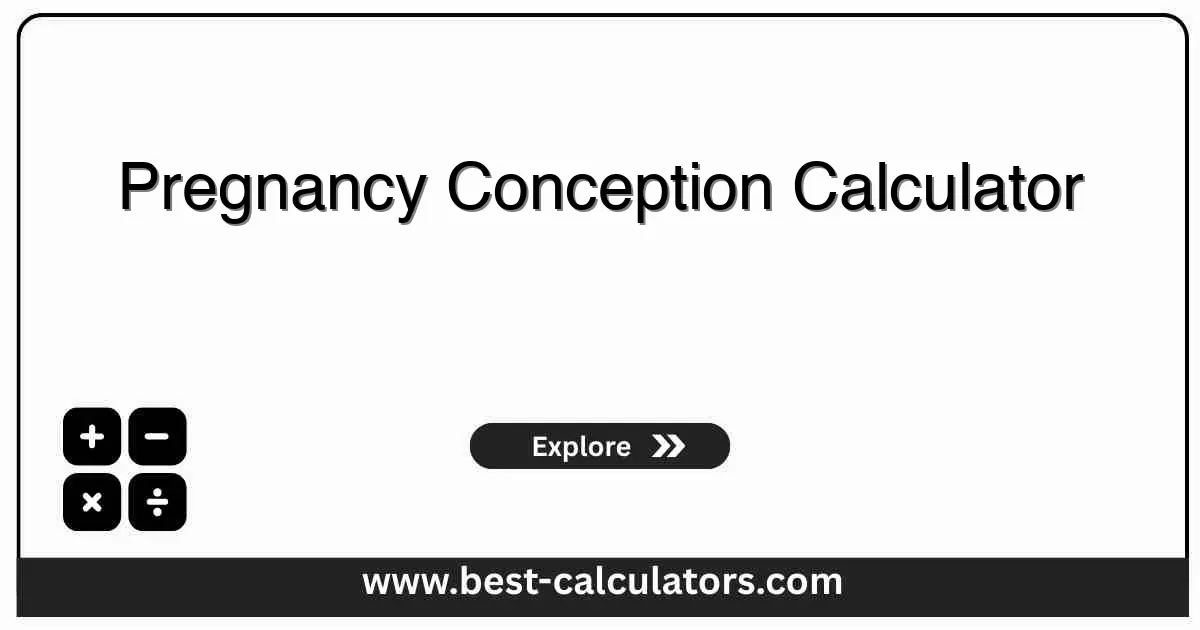Pregnancy Conception Calculator - Calculate When Conception Occurred
Calculate your conception date based on due date or last menstrual period using reverse pregnancy calculations and ovulation timing estimates
Pregnancy Conception Calculator
Your Conception Results
What is a Pregnancy Conception Calculator?
A Pregnancy Conception Calculator estimates when conception likely occurred based on either your due date or last menstrual period. Using reverse pregnancy calculations, it determines the approximate date of fertilization by working backwards from known pregnancy milestones.
This calculator helps you:
- Determine approximate conception date for family records
- Identify the likely ovulation and fertile window
- Calculate conception from ultrasound-based due dates
- Understand pregnancy timeline and early development
- Plan future conception timing for family planning
For calculating your pregnancy due date from LMP or conception date, use our Pregnancy Calculator to estimate delivery date and track gestational age by trimester.
To track recommended weight gain during pregnancy based on BMI, try our Pregnancy Weight Gain Calculator for IOM guidelines and healthy pregnancy weight management.
For understanding ovulation timing and fertile windows for conception, use our BMI Calculator to assess your pre-conception health and optimal weight for pregnancy.
To calculate daily calorie needs for pregnancy nutrition planning, try our Calorie Calculator to support healthy fetal development with adequate nutrition.
How Pregnancy Conception Calculator Works
The calculator uses two methods for conception dating:
Conception window calculation:
- Ovulation typically occurs 12-16 days before next period
- Egg survives 12-24 hours after ovulation
- Sperm can survive up to 5 days in reproductive tract
- Fertile window spans 6 days ending on ovulation day
The calculator provides a 3-5 day conception window because intercourse occurring several days before ovulation can still result in pregnancy. This accounts for sperm survival time and ovulation timing variability.
Understanding Conception Timeline
Ovulation Phase
Ovulation releases a mature egg from the ovary, typically 14 days before the next menstrual period. The egg survives 12-24 hours, creating a brief fertilization window.
Fertilization Moment
Conception occurs when sperm penetrates the egg, usually in the fallopian tube. This typically happens within 24 hours of ovulation but can occur from intercourse up to 5 days prior.
Implantation Timing
After fertilization, the embryo travels to the uterus and implants 6-12 days post-conception. Implantation marks the start of hormone production detectable by pregnancy tests.
Pregnancy Dating
Medical dating starts from LMP (2 weeks before conception) because it's more reliably known. Gestational age is always 2 weeks more than fetal age from conception.
How to Use This Pregnancy Conception Calculator
Choose Calculation Method
Select whether to calculate from due date or LMP
Enter Known Date
Input your due date or first day of last period
Adjust Cycle (If Needed)
For LMP method, specify your typical cycle length
View Conception Estimate
See estimated conception date and fertile window
Benefits of Conception Calculator
- • Family Planning Records: Document approximate conception date for personal and family history records.
- • Fertility Awareness: Understand when conception occurred to identify fertile patterns for future planning.
- • Pregnancy Timeline Clarity: Better understand early pregnancy development stages and milestone timing.
- • Medical Discussion: Provide context for healthcare discussions about pregnancy dating and early development.
- • Birth Spacing Planning: Calculate ideal conception timing for desired birth spacing between children.
- • Ovulation Understanding: Learn about your ovulation patterns and fertile window characteristics.
Factors Affecting Conception Timing
1. Cycle Regularity
Regular cycles make conception date estimation more accurate. Irregular cycles cause ovulation timing variability, making precise conception dating more challenging.
2. Ovulation Variation
Ovulation can occur 12-16 days before next period, not always on day 14. Stress, illness, and lifestyle factors can shift ovulation timing by several days.
3. Sperm Survival
Sperm can survive up to 5 days in optimal cervical mucus conditions. This means intercourse several days before ovulation can result in conception, widening the window.
4. Luteal Phase Length
The luteal phase (ovulation to next period) is typically 12-14 days. Variations in luteal phase length affect ovulation timing calculations from due dates.
5. Ultrasound Accuracy
Early ultrasound dating (before 13 weeks) is most accurate for determining gestational age. Later ultrasounds are less precise due to individual fetal growth variations.

Frequently Asked Questions (FAQ)
Q: How do I calculate my conception date?
A: Conception date can be calculated by subtracting 266 days from your due date, or by adding 14 days to the first day of your last menstrual period (assuming a 28-day cycle). This estimates when fertilization likely occurred.
Q: How accurate is the conception date calculator?
A: The conception calculator provides an estimate based on standard ovulation patterns. Conception typically occurs within a 24-hour window, but sperm can survive up to 5 days, making the exact conception date difficult to pinpoint precisely.
Q: Can I calculate conception date from ultrasound?
A: Yes, early ultrasound measurements (especially before 13 weeks) provide accurate gestational age estimates. From ultrasound dating, subtract 266 days from the calculated due date to estimate conception date.
Q: Why is conception date different from LMP?
A: Conception occurs approximately 14 days after the first day of your last menstrual period in a typical 28-day cycle. Pregnancy dating starts from LMP, not conception, because LMP is easier to determine accurately.
Q: Does cycle length affect conception date calculation?
A: Yes, cycle length significantly affects conception timing. Women with longer cycles ovulate later (conception occurs later), while shorter cycles mean earlier ovulation and conception. The calculator adjusts for cycle length variations.